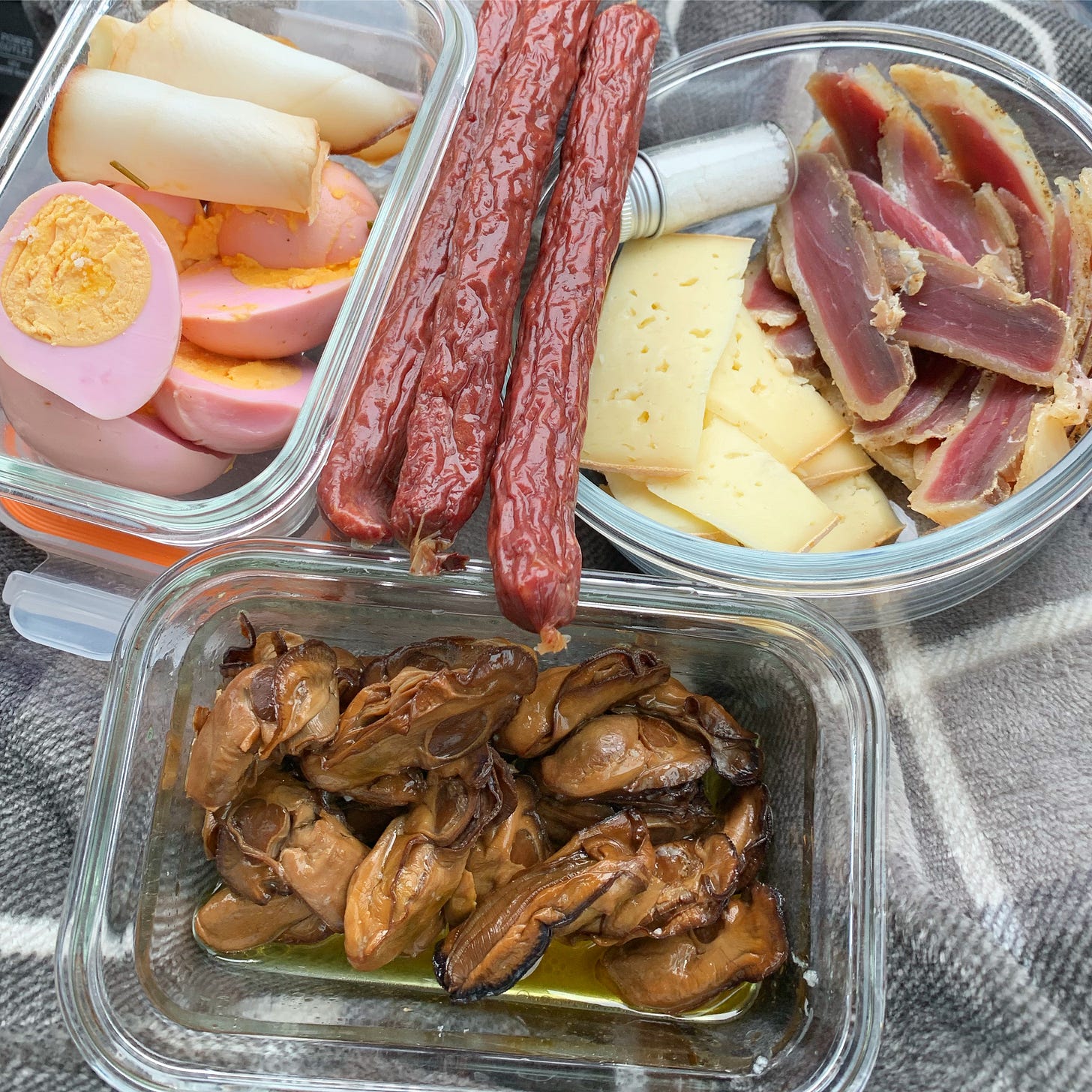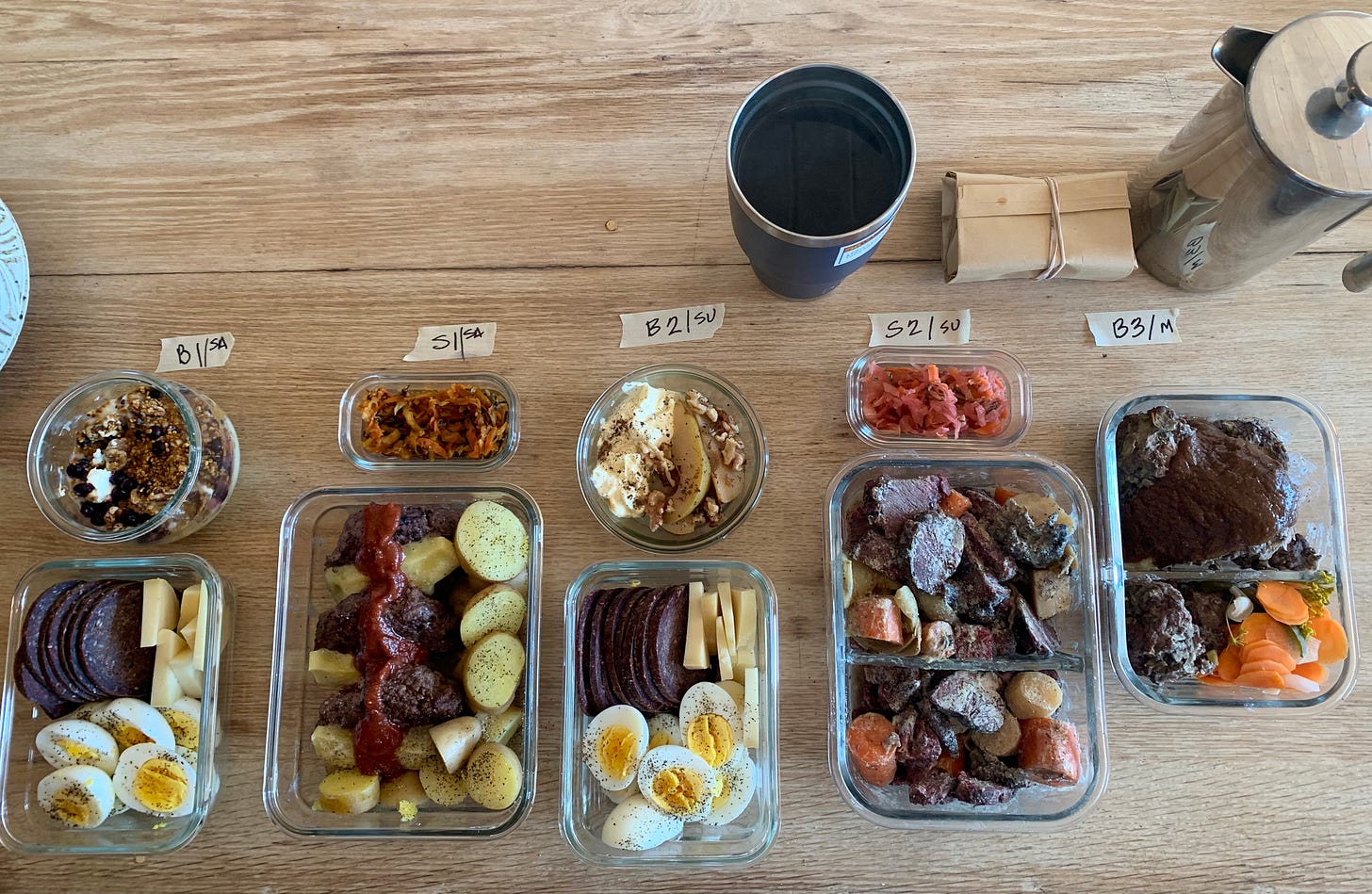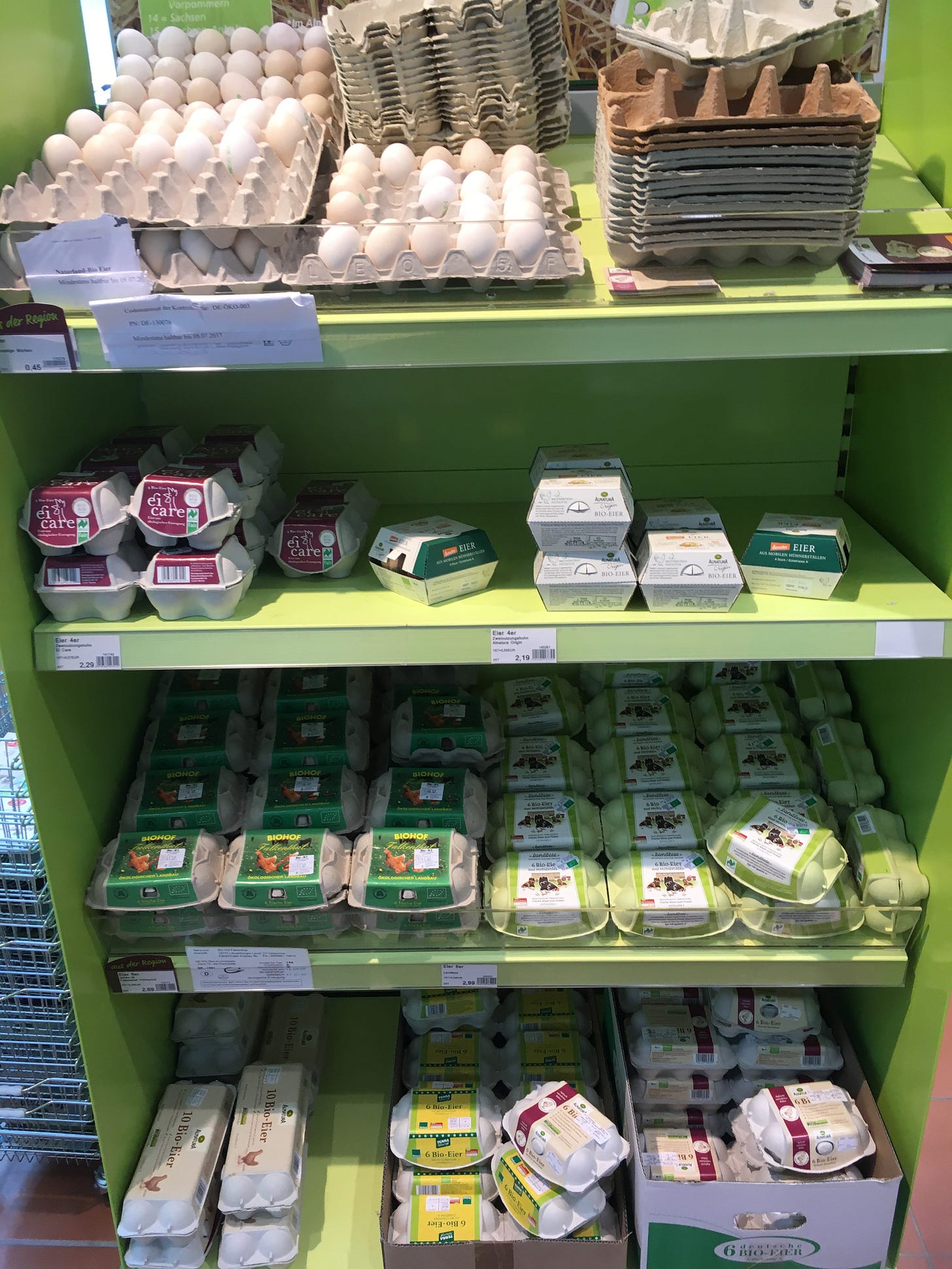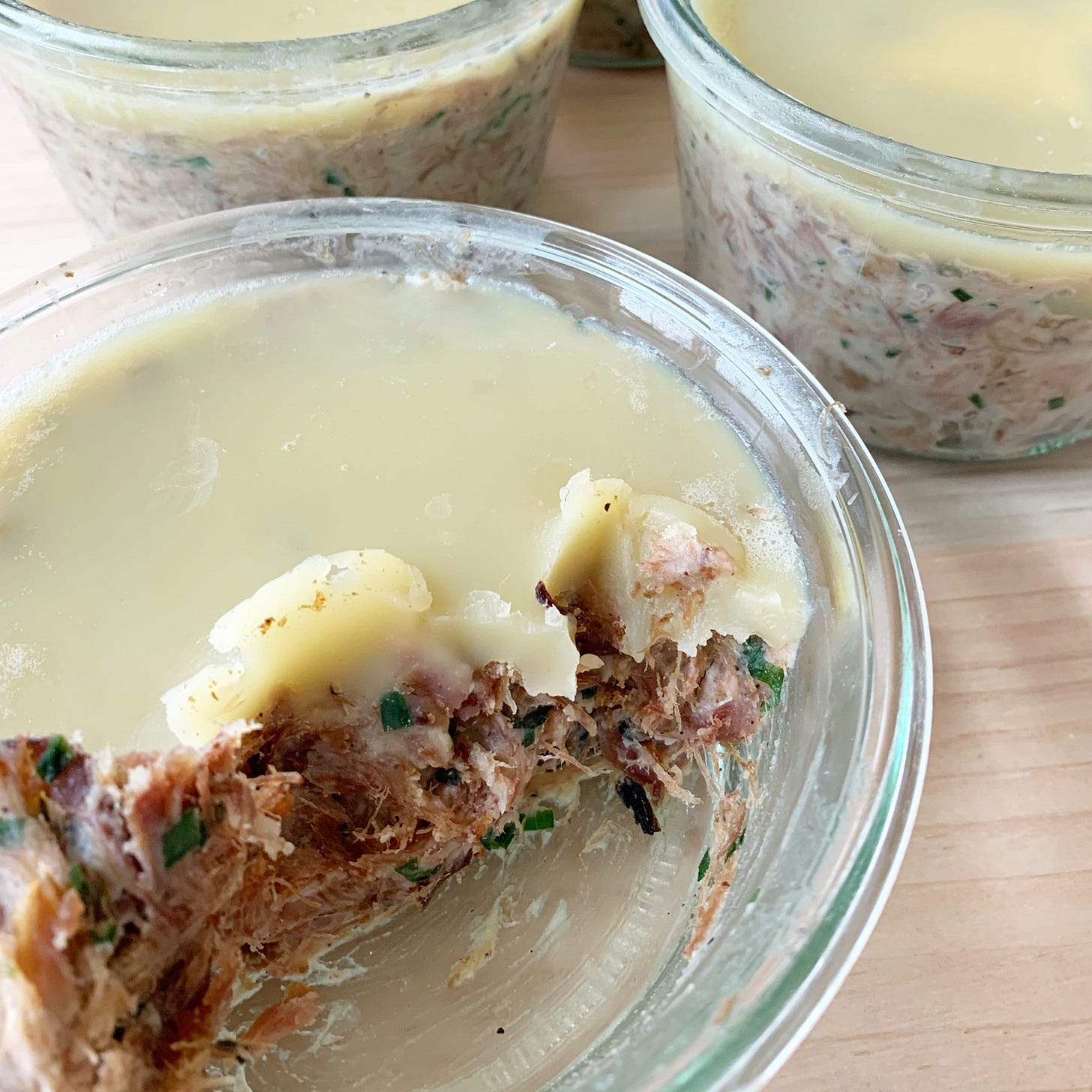food on the go
staying nourished no matter the locale
I tried to do a bit of math in my head to figure out how many lunches and various other meals I have made in my time as a wife and mom. How many? The nearest I can figure is tens of thousands. I got my husband to give me a hand with that calculation and it’s confirmed, “Yup, tens of thousands.”
I’ve had some requests to do some essays on the more ‘nuts and bolts’ types of home economics things I’ve picked up over the years, so this seems a good place to start. “Home economics” - did any of you take that in school? I did. We had to. We learned how to cook and sew (badly) and how to do a budget. I also had to do “shop class” where we learned how to weld, develop a photograph, and build things out of metal. I even took a year of power mechanics where I got to work on my first car, a butter yellow, 1970 Opel GT. Whatever happened to those things being mandatory? Does cooking class in schools even exist anymore? For that matter, does cooking in the home exist anymore?
First things first - I have always made our own meals whenever we went somewhere. This was for a couple reasons:
finding healthy food on the go is like finding a needle in a haystack,
we wanted to focus on whatever we were doing (not driving around looking for food),
we wanted to feel good doing what we were doing (not dealing with grumpy kids or tummy aches),
and we just simply couldn’t afford it.
There’s the obvious things that show up around homemade food when your kids are small. Some kid munching on lunchables is going to tease your kid for their thermos full of rich smelling stew. It’s inevitable. And I, being a mama Leo lion, would have been happy in those moments, when my little tot came home sad that some classroom jerk told her that her food stunk, to have found him and tied him to a tree. Alas, one must do what one can to stay out of prison.
It’s in those moments that we find ourselves in yet another one of those ‘prepare your child for life’ type of painful lessons. The answer is not to start sending your kid lunchables, too. The lesson, like many, is in educating your child about why you eat what you eat and what is in those foods that so many of their pals are eating. I remember having those conversations with our kids early and often. It’s a weird time when processed foods have become normalised to the point that whole, real foods are suspect. We talked about that as a family, too. The conversations around food included topics covering farming, economics, the environment, ethics, and health. It turns out that this will just be another example of your efforts as parents growing both healthy AND resilient kids in our modern world. A world that normalises perversion on many fronts requires us to stand strong in our own convictions.
After all of the meals I have made over the years, I have learned how to do a little calculation of days gone x number of people to feed x meals/day + snacks. We had kids in competitive rowing and hockey so there were often times where we were driving for hours and staying somewhere over a weekend. Most of the families would eat out for the weekend, but we would show up with our travelling caravan, carrying our old 1960s metal Coleman coolers loaded with glass dishes of food. I remember all the times when the other kids would migrate over to our hotel room wondering if I had any of the “magic chocolate milk” to share. I never told them that it was raw cow’s milk with raw eggs in it. Ha. They just thought it was dreamy.
The above images show how I approach a multi-day excursion. I took these pictures the other day when my husband, Troy, was going to work for two night shifts. Early on in my mothering days, I would just bring big containers of food and figure we would all have at ‘er and surely there would be enough for us all. After too many times running out of food or having an abundance of one thing but not enough of another, I switched to individual meals. One container, one meal, one person. Yes, when there were five of us on the move, that meant I had a lot of glass containers and jars to haul around. How do I know how much to give them in each container? I don’t know, instinct I suppose. But they all tell me it’s always “just right”. I suppose if you aren’t sure, you could ask them if they needed more or watch to see if food is coming back home with them and adjust.
I start by figuring out how many meals are needed. In the example of the meals I was making for Troy the other day, I know that he eats twice a day and he was going to work two night shifts plus his driving time. He doesn’t eat during his night shift in an effort to not mess with his circadian rhythm even further. So his meals are before and after his shift. During his shift, he just consumes electrolytes in his water.
After counting the meals I need to make, I label their spots on the table with masking tape. S1 is just supper one. B2 is the second day’s breakfast, S2 is the second day’s supper. You get the idea. That tape will go on the containers when they’re ready to be packed up. That way, when I have a couple containers for a meal - say a container with soft boiled eggs and ham in it that’s supposed to be eaten in combination with a jar full of yogurt or something, he knows what goes together. It might seem a little micro-manage-y, but I can tell you that when my husband is working or the kids were eating between games or demands in a tournament, they just want to reach in the bag and have it all laid out. Food has always been my domain in our family. I make it, they express gratitude and appreciation. It’s all good.
I have always been a big volume cooker. If I’m making something, it’s in big proportions. Leftovers are a lifesaver when you’re packing up meals later. For things like roasted vegetables, stews, roasts etc.. if I wasn’t putting it all into a container for the next day’s school lunch, it was going into containers in the freezer to be pulled out on short notice. In the above picture, you might notice that the last couple of meals in the lineup are frozen. That’s done on purpose. When I pack up those meals, the frozen ones will keep the others cold and slowly thaw out over the next day. By the time day two or three comes, the frozen meals have thawed and kept themselves quite nicely.
This might be a good time to address the issue of food safety. I’m sure a few of you have heard the heresy that is my approach to “food hygiene”. One need not go too far back in our history to a time when our handling of food with bleach and gloves was not necessary. What changed? Well, the food of course. Sick animals deliver sick flesh. It’s the whole reason pasteurization of milk exists. It’s why chicken is surely loaded with salmonella until it’s cooked to smithereens. It’s why, in North America at least, everyone cans their tomato sauce and peaches according to the USDA guidelines, cooking them to death and then topping it up with a water bath to boil out all of the possible offenders lurking within. Did you ever notice that if you get a cookbook from Europe, they don’t process their food that way? How come they’re not all dead? Questions, I got ‘em.…
I bring up the food safety hysteria to simply suggest that if you have healthy food, common sense dictates a level of care around your kitchen, but you might just survive eating your lunch if it hasn’t been in a fridge for three hours. When I cook a roast with root vegetables in winter, it sits on my stove for a day or two until it’s eaten. I see that in all of the farm kitchens I visit. Our eggs never see a fridge. They live in a bowl on our counter because we do not wash the protective bloom off of them (in Europe they are sold on shelves because they have not adopted the nasty practice of washing their porous eggs in chlorine like we do here in North America). So, for the inevitable and oft asked “how do you keep your kids meals cold?” I don’t. If it’s a multi-day excursion, we use coolers. If Troy is working a shift, he doesn’t even use a fridge. If he’s working two shifts in a row, he will put the second day’s food in the fridge.
How to keep the food warm? Well, in winter, thermoses are a boon. Steaming soups, curries, and stews are a lovely little hit o’ love in the middle of the cold winter day. Aside from that, no meal on the go is eaten warm. I suggest everyone get accustomed to that, it will make your life so much easier if you aren’t tethered to having everything you eat heated just so. If you take a meal out of your fridge and eat it at lunch, it should be pleasantly room temperature. It need not be hot to be eaten. I’ve never owned a microwave and would never use one. Options are limited outside of a thermos, but if you just need warm food, you could heat it up at home and put anything in there too.
So what’s in these meals I’m showing? The same thing that we eat everyday. Just like breakfast need not be special foods, the food we bring with us isn’t any different from what we eat at home. We can still use a fork right? No need to squish everything between two slices of bread. In the above example there is stew and brisket, soft boiled duck eggs, fermented veggies of all types, roasted veggies and potatoes, beef summer sausage, canned pears with cream and bee pollen, raw cheeses of all ilk, and organic coffee to go with his traveling french press and kettle, everything cooked in tallow, duck/goose fat, ghee, or topped with raw butter. These are the exact same kind of lunches our kids would be fed whether they were at school or at a tournament or at our table. No difference other than portion size. More energy demands, more energy given.
How in the world could you ever buy that?

I think this is a good time to address the issue of kids indulging in treats as a social phenomenon. Over the years, I noticed a shift of degrees in what was classified as celebration worthy in a classroom or sport team dressing room. Parents began doling out the neon green and pink frosted cupcakes to the kids for all manner of reasons. A teammate’s birthday would suffice. Valentine’s day or easter or thanksgiving, too. A big win warranted a sugar binge. A big loss would even see jugs of gatoraid passed out to help them recover for the next challenge. Well meaning parents stood by the locker room doors handing out Mars bars and chocolate milk cartons to “replenish energy for the next big game”. Inevitably, the next big game, a few hours later, would result in zippy little maniacs that would quickly slide into sugar crashing sloths moping around the ice come the midway point of the first period. I never once told my kids to say no to those foods, they just did because they learned that they felt like poop if they ate them.
How I handled those situations was case dependent. When I got word that a birthday was happening and there would be cake or that someone was bringing cookies to school for Rock Awareness Day, I would bring a version of that “treat” for my kid. That’s probably a whole essay onto itself, but for now I wanted to just mention that I had my finger on the pulse of those sugar dealers and learned to head them off with ease. At the beginning of a school year or a new season with a sports team, I would talk to the teacher/coach/parent’s group lead, and let them know that my kid had food allergies (not anaphylactic, but enough to make them sick) and it would be great if they could give me a heads up on birthdays or other upcoming things so I could make sure my kiddo had something too. Most people are pretty agreeable to this because they really, really, want your kid to get their fix, too. I would still try to be aware of the times that there was going to be an obvious celebration (end of season parties and the like). If I got word that little Suzie was turning 8 and her mom was going to bring in cupcakes for the team in the dressing room, I would pull out one of my homemade, organic cupcakes I had stored in my freezer for just such times.
I was a fabulous baker, a skill I do believe is in my DNA from a Slovak Bapka that was a gifted baker and cook. My kids, who were not used to getting such delights on the regular, would light up when they got their treat. They didn’t give a hoot that it was different looking, they were just thrilled to indulge! They saw that food for what it was - a rare treat to be savoured. That was my approach even at other kid’s birthday parties. It was easy enough for them to agree to my version of the treats on offer after they recognised how eating junk food made them feel.
Lest you think that every parent and coach thought me a pain in the ass, I will share that by and large, everyone was pretty receptive to my approach. There were even a few years, when I was still a practicing nutritionist, when I was asked to give a presentation on how to fuel up for games or during multi-day tournaments. It was pretty rewarding to see how, during weekend long competitions, the other teenagers on our daughters’ teams started gravitating to their meals and snacks. “Send more mom, they’re eating all my food!” Of course, I did happily. For any snide remarks or eyeball rolls I got for my “extremism”, well, so what? My job was to nourish little bodies, not placate the insecurities of other adults. I just got comfortable with always being on the edges which is a great way to find the authentic relationships in the mix.

Along with my freezer stash of treats (hide them under the frozen organs or they have a tendency to dwindle), I also kept jars of dehydrated things that would work for snacks. When my husband was in the military, I commonly made pemmican and jerky with both meat and organs. He would take things like that, with these little cardboard cups of marrow/tallow butter, to augment his food. I also properly prepared nuts, soaking and dehydrating, and kept them in jars in the freezer so I could pour some into a paper bag with some dehydrated fruit when rushed. Another common “in a rush” food was a quick “milkshake” I would zip up in the vitamix. It was just whole, raw milk with some coconut oil, a whack of raw eggs, vanilla bean, and salt. If things were getting really wild and it was summer, some fruit might find it’s way in there. I would zip that up, pour it into jars or thermoses, and away we would go.
I was specifically a sports nutritionist when I practiced as a nutritionist so I did have a focus on performance when making those weekend sports tournament and week-long army exercise meals. I don’t know how important that is really. Simply, I think that if you eat well, with adequate proteins and fats and unprocessed carbohydrates, most people, especially little people, will do quite well without anything extra. Their blood sugars should be steady, their moods even keel, their energy robust.
We also travel with our own water stored in glass jars, all wrapped in tea towels in a crate. If we run out, we buy mineral water in glass. We have an accoutrement bag in a food tote that has good salt, utensils, pre-measured electrolytes, and napkins in it. There’s also one of those in each car.
Obviously, if your family eats bread, the ubiquitous sandwich makes things easier, but I’d recommend not relying on that entirely. Soups and stews were our ‘sandwich’ in the winter. Big salads loaded with all manner of things came into play in the months when those fresh veggies grow here. Summer preserved fruit was a nice treat on yoghurt I put in a jar. And the chutneys and fermented foods made their appearances on top of a piece of beef roast or duck leg.
One last thing, I confess that when I was a kid, I was the ‘weirdo’ that was sent lunches of peanut butter and honey sandwiches on brown bread with an apple. If I was lucky, there was a wheatgerm cookie in there that was hard as a rock (children of hippies understand what I’m talking about). I got flack for the brown bread. I traded my red delicious apple (still hate them) for little, red boxes of Sunmaid raisins or any candy some fool was willing to part with. I even threw out some of the tuna sandwiches.
I am a huge proponent, and strongly believe, that we are our children’s teachers and guides. There seems to be a new train of thought in parenting that presupposes that our children come to this earth with some saintly knowledge, balls of perfection are they, that we mustn’t tarnish. I am not of that camp. Before we had our farm, we bought food from farms. I would drive hours to buy raw milk, cream, yoghurt and cheese. We would bring the kids to meet the farmers we were buying our meat and eggs from. They came to know the farmers as much as we did. They developed relationships with the people growing and raising our food. We explained why we had to drive to the countryside to find the nourishing food to build their bodies and minds. Why didn’t we go to the grocery store? We explained it. What’s wrong with eating X when everyone else is eating it? We explained it. Our kids could tell any adult all about organic foods, glyphosate, human sewage that was used on fields as fertiliser, and all the other reasons we avoided certain foods. They could also tell anyone that wanted to know about the benefits of egg yolks, raw milk, and the luscious yellow fat from the grass fed bison they were being nourished by.
I asked my adult kids if they ever threw away any of their food. The answer, “Once or twice, I felt way too guilty to throw out food.” Our deal was that if they didn’t want their food, they should just bring it home, and they did. If it was too much or they didn’t want it, the food came home where it got put into a soup or stew, someone else ate it, or we had a happy dog. And I did not chastise them for wasting my time.
I was kind of laughing at myself while I wrote this. I think most essays on “food on the go” would tell you all about the containers or give you tips on ‘veggies and dip’ and prepackaged things to ‘make life easier’. I think we can still be smart with our time, as I’ve hopefully outlined, while nourishing ourselves and our people, outside the home. It might seem like a lot reading it as I’ve written it, but truth be told, it just becomes another rhythm in your life, an alignment of your efforts with your values. Like any task, we can be resistant and bitter or we can be grateful to have such love in our life to dedicate ourselves to. And in that demonstration of our love we get to nourish the beautiful humans that nourish us right back in their way, every day, too.






Tara, any time you have the hankering to write informative essays like this, please do! This was great information and inspiring. Very cool 😎
I enjoyed reading every word, Tara! You are an inspiration to many I am sure. You have given your family so much love in every bite of the food you not only prepared.. but raised as well. I love reading your essays.💕